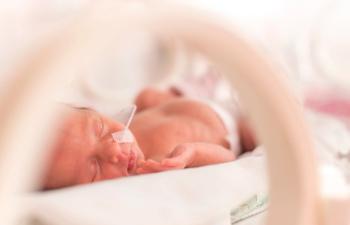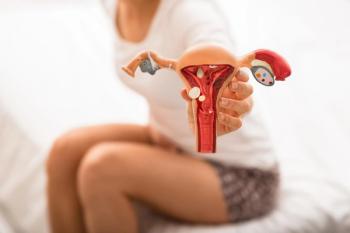
Is it time to limit IVF transfers to one embryo?
What's the right number of embryos to transfer in each patient? An authority on the subject discusses the newly released ASRM committee guidelines and their practical implications.
LIMITING EMBRYO TRANSFERS
Is it time to limit IVF transfers to one embryo?
By Norbert Gleicher, MD
What's the right number of embryos to transfer in each patient? An authority on the subject discusses the newly released ASRM committee guidelines and their practical implications.
Although ovulation-inducing drugs can convert the naturally occurring monofollicular ovarian response into a polyfollicular response, the resulting release of more than one egg significantly increases the risk of multiple conceptions. Widely recognized for decades, it occurs in 5% to 10% of cycles treated with clomiphene citrate and in 15% to 20% of gonadotropin-induced cycles.1,2
At first, high multiple pregnancy rates were widely accepted and considered a mostly unpreventable complication of successful infertility treatment. But although many patients still welcome multiple births (especially twins and, to a lesser extent, triplets), the medical community's position has evolved.3
That's because the resulting epidemic of multiple births has produced so many premature deliveries over the last few decades; and that in turn has taken a heavy medical, emotional, and economic toll.4 Clearly, good infertility care requires doing all we can to reduce the risk of multiplesa consensus that's being echoed by the American Society for Reproductive Medicine's (ASRM) updated committee report guidelines issued this summer. Although the wider use of ovulation-inducing drugs, usually in conjunction with gonadotropins, is more often to blame for this epidemic, much of it has been wrongly attributed to the explosive growth of in vitro fertilization (IVF).5-7 Such ovulation induction cycles will result in triplets or even higher-order multiples in roughly 9% of all pregnancies.8 In contrast, in our experience, if IVF transfer guidelines are followed, the risk of a triplet or higher pregnancy is less than 1%.
Not everyone views twin pregnancies favorably. Most European and Canadian colleagues consider only singleton pregnancies a true IVF treatment success.9,10 Reproductive endocrinologists in the United States, on the other hand, seem more accepting, perhaps in support of their patients' strong desire for twin pregnancies (more than 60% prefer them over a singleton).3,11
Varying insurance coverage affects attitudes, as well. For example, in Europe, where national insurance covers most medical treatments, the governments have a strong interest in discouraging expensive premature deliveries that stem from multiple gestations. In the US, in contrast, where insurance doesn't usually cover infertility treatment, patients often opt for aggressive treatment to maximize their chances.12 Uniformly, higher pregnancy odds come with the cost of higher multiple pregnancy risks; of course, good clinical care mandates finding the right balance between the two.
Will IVF solve the multiple birth epidemic?
We now see IVF as a potential solution to the problem. Unlike ovulation induction cycles, this approach allows complete control over the multiple risk, since the patient and physician largely decide the number of embryos to be placed into the uterus. During the early days of IVF, many embryos were transferred to compensate for very low implantation rates. Put another way, at that time IVF centers simply bought more tickets in the lottery to improve pregnancy chances. As embryo culture conditions started to improveand with them embryo implantation rateslarge embryo transfer numbers led to a high percentage of multiple and even higher-order multiple pregnancies. One author recently called the transfer of multiple embryos at that time ethically irresponsible, and suggested it should have never been allowed. Keep in mind, however, that IVF would never have developed into the successful treatment it is today had initial attempts not led to minimally acceptable pregnancy rates.13,14
The so-called implantation rate, the chance of a single embryo implanting and leading to pregnancy, also defines the risk of multiples. Implantation rates vary from patient to patient, from IVF program to program, and depend on the ability to select out the top embryos from a cohort. Finally, implantation rates are highly dependent on a patient's age. Good quality embryos produce high implantation rates, while poor quality embryos will not. Since embryo quality is mostly derived from the oocyte (semen seems to only make a minor contribution), the ebbing implantation rate with advancing fe- male age is mostly due to aging oocytes. Consequently, as women age, they need to have more embryos transferred to maintain good pregnancy rates.
In the US this recognition has led to age-specific embryo transfer guidelines (Table 1), published by The Society for Assisted Reproductive Technology (SART) and its parent organization, the ASRM.15 Under the Practice Committees' newly revised guidelines, the recommended number of embryos transferred increases from one or two under age 35 to five after age 40. The revised guidelines for the first time distinguish between women in the 38-to-40 age group, for whom a maximum of four embryos transferred is now recommended, compared to women just a few years younger between ages 35 and 37 (who should have a maximum of three), barring unusual circumstances for either age group. For example, the guidelines allow for other embryo quality considerations, which may affect implantation rates. Such an approach appears sensible, since it allows clinicians to adjust care to each patient's specific condition.
TABLE 1
Summary of new SART/ASRM embryo transfer guidelines
In many European countries such individualized care is either legally prohibited by law or precluded by professional guidelines. For example, Austria considers it a crime to transfer more than three embryos regardless of the patient's age.16
Single embryo transfer
Europe is aggressively pursuing the goal of single embryo transfer, with more and more European colleagues arguing in favor of mandating or at least strongly recommending that strategy.17,18 Indeed, this approach appears to represent the ultimate solution to the multiple birth epidemic in infertility since, with the exception of very rare monozygous twins, single embryo transfer virtually guarantees a singleton pregnancy. But as appealing as that may be, it should be pursued with caution. Many investigators have demonstrated that in carefully selected patients, single embryo transfer will still lead to high pregnancy rates.10 However, for quite obvious reasons, the same will not necessarily be true for everyone. To transfer only a single embryo into a 42-year-old patient (who has more embryos available for transfer) makes no sense! It will lead to dismal pregnancy rates, while the transfer of multiple embryos in such an age group is very unlikely to cause multiple implantations.
Based on a statistical analysis, we defined which patients would maintain good pregnancy rates even with only single embryo transfer (Table 2). Not surprisingly, they represent young women (though not the youngest) with excellent ovarian function who very often are in infertility treatment for reasons unrelated to their ovaries and ovarian function. For such women, single embryo transfer appears absolutely indicated. However, in my opinion, to push the concept further or to even mandate single embryo transfer for everybody simply does not make sense.
TABLE 2
Ideal patients for single embryo transfer*
In 2000, our program saw a dramatic decrease in triplet pregnancies when we introduced transfer guidelines that were practically identical to those later published by SART/ASRM (Table 3). However, adherence to these guidelines still resulted in a limited number of triplet pregnancies, which were concentrated in women between ages 35 and 40, who received three embryos. Therefore in 2003, we further modified our approach to women in this age group by reducing the number of embryos transferred from three to two, as long as the patient produced five or more high-quality embryos.
TABLE 3
Guidelines can cut triplet pregnancies
In Table 4, therefore, I suggest minor modifications to the newly revised SART/ASRM guidelines, recognizing that some carefully selected patients would, indeed, make excellent candidates for single embryo transfer, while a two-embryo transfer is still best for most women up to age 35. In my view, selected women between ages 35 and 40 should also receive only two embryos, but most will need three to maintain good pregnancy rates, without creating a triplet risk. For women over age 40, the problem is usually not too many but too few embryos, given the decline of egg and embryo counts with advancing female age.
TABLE 4
Comparing SART to authors suggested modified embryo transfer guidelines*
Why IVF is the wise choice
IVF has become the predominant infertility treatment in many medically developed countries for two reasons: the great improvement in IVF pregnancy rates per treatment cycle and the fact that IVF allows, for the first time, control over the multiple pregnancy risk, traditionally associated with infertility treatments.
At a time of strained financial resources, cost-effective medical care is more important than ever. Just one high-order multiple pregnancy leading to a very premature delivery may cost hundreds of thousands of dollars.4 Obviously, preventing just one such pregnancy through IVF represents a huge financial savings.
Viewed from such a vantage point, IVF today appears to be not only the most successful infertility treatment, but also the most cost-effective approach to both female and male infertility. Isn't it high time to recognize this fact?
Dr. Gleicher is the owner of the Center for Human Reproduction (CHR), an infertility practice in New York, N.Y.
REFERENCES
1. Pasqualotto EB, Faycone T, Goldberg JM, et al. Risk factors for multiple gestation in women undergoing intrauterine insemination with ovarian stimulation. Fertil Steril. 1999;72:613-618.
2. Dickey RP, Taylor SN, Lu PY, et al. Relationship of follicle numbers and estradiol levels to multiple implantation in 3,608 intrauterine insemination cycles. Fertil Steril. 2001;75:69-78.
3. Gleicher N, Campbell DP, Chan CL, et al. The desire for multiple births in couples with infertility problems contradicts present practice patterns. Hum Reprod. 1995;10:1079-1084.
4. Collins JA. Too much of a good thing. J Soc Obstet Gynecol Can. 2000;23:177-180.
5. Luke B. The changing pattern of multiple births in the United States: maternal and infant characteristics, 1973 and 1990. Obstet Gynecol. 1994;84:101-106.
6. Martin JA, Park MM. Trends in twin and triplet births: 1980-97. Natl Vital Stat Rep. 1999;47(24):1-16.
7. Norwitz ER. Multiple pregnancy: trends past, present and future. Infertility and Reproductive Medicine Clinics of North America. 1998;9:351-369.
8. Gleicher N, Oleske DM, Tur-Kaspa I, et al. Reducing the risk of high-order multiple pregnancy after ovarian stimulation with gonadotropins. N Engl J Med. 2000;343:2-7.
9. Pennings G. Avoiding multiple pregnancies in ART: multiple pregnancies: a test case for the moral quality of medically assisted reproduction. Hum Reprod. 2000;15:2466-2469.
10. Gerris J, Van Royen E. Avoiding multiple pregnancies in ART: a plea for single embryo transfer. Hum Reprod. 2000;15:1884-1888.
11. Kalra SK, Milad MP, Klock SC, et al. Infertility patients and their partners: differences in the desire for twin gestations. Obstet Gynecol. 2003;102:152-155.
12. Jones HW, Schnorr JA. Multiple pregnancies: a call for action. Fertil Steril. 2001;75:11-13.
13. Lambert RD. Safety issues in assisted reproduction technology: the children of assisted reproduction confront the responsible conduct of assisted reproductive technologies. Hum Reprod. 2002;17:3011-3015.
14. Gleicher N. Safety issues in assisted reproduction technology. A rebuttal. Hum Reprod. 2003;18:1765-1766.
15. American Society for Reproductive Medicine. Guidelines on Number of Embryos Transferred. A Practice Committee Report. (Submitted for publication to Fertility and Sterility and placed on the ASRM Web site in June 2004. This file will be replaced by the version published in Fertility and Sterility when it becomes available.)
16. Shenfield F, Pennings G, Sureau C, et al. The moral status of the pre-implantation embryo. Hum Reprod. 2001;16:1046-1048.
17. Gerris J, DeNeubourg D, Mangelschots K, et al. Elective single day 3 embryo transfer halves the twinning rate without decrease in the ongoing pregnancy rate of an IVF/ICSI programme. Hum Reprod. 2002;17:2626-2631.
18. Hazekamp J, Bergh C, Wennerholm UB, et al. Avoiding multiple pregnancies in ART: consideration of new strategies. Hum Reprod. 2000;15:1217-1219.
DR. GLEICHER is Adjunct Professor of Obstetrics and Gynecology, New York University-School of Medicine, New York, N.Y., Visiting Professor of Obstetrics and Gynecology at the Yale University-School of Medicine, and the owner of The Center for Human Reproduction (CHR), New York, N.Y.
Norbert Gleicher. Is it time to limit IVF transfers to one embryo? Contemporary Ob/Gyn Aug. 1, 2004;49:73-85.
Newsletter
Get the latest clinical updates, case studies, and expert commentary in obstetric and gynecologic care. Sign up now to stay informed.










